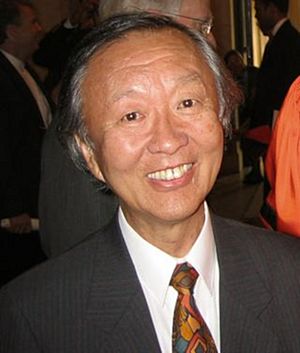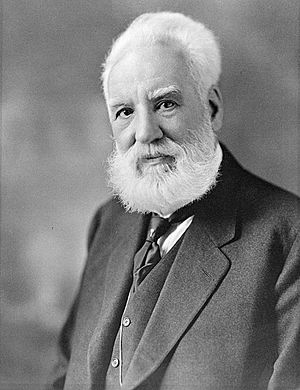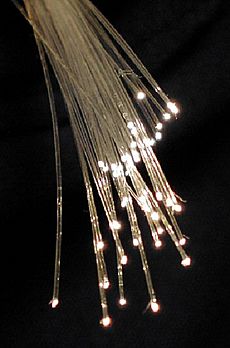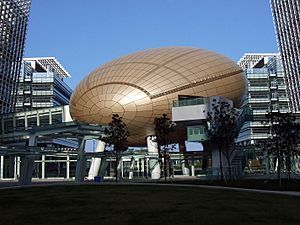Charles K. Kao facts for kids
Quick facts for kids
Charles K. Kao
|
|
|---|---|
| 高錕 | |

Charles K. Kao receiving an honorary degree from Princeton University in 2004
|
|
| Born |
Charles Kuen Kao
November 4, 1933 |
| Died | September 23, 2018 (aged 84) |
| Citizenship | United Kingdom United States |
| Alma mater | University College London (PhD 1965, issued by University of London) Woolwich Polytechnic (BSc 1957 ) |
| Known for | Fiber optics Fiber-optic communication |
| Spouse(s) |
Gwen May-Wan Kao
(m. 1959) |
| Children | 2 |
| Awards |
|
| Scientific career | |
| Fields | Physics |
| Institutions | Chinese University of Hong Kong Standard Telephones and Cables ITT Corporation Yale University |
| Doctoral advisor | Harold Barlow |
| Charles K. Kao | |||||||||||||||||||
|---|---|---|---|---|---|---|---|---|---|---|---|---|---|---|---|---|---|---|---|
| Traditional Chinese | 高錕 | ||||||||||||||||||
| Simplified Chinese | 高锟 | ||||||||||||||||||
|
|||||||||||||||||||
Sir Charles Kao Kuen (November 4, 1933 – September 23, 2018) was a brilliant electrical engineer and physicist. He is famous for his groundbreaking work on fiber optics, which changed how we communicate. In the 1960s, Kao figured out how to send digital information using glass fibers and lasers. This discovery was super important for the development of the Internet and modern communication.
Kao was born in Shanghai, China. His family moved to British Hong Kong in 1949. After high school, he went to London to study electrical engineering. He became known as the "godfather of broadband" and the "father of fiber optics." He continued his work in Hong Kong and the United States. In 2009, he won the Nobel Prize in Physics for his work on transmitting light through fibers. The next year, Queen Elizabeth II knighted him for his amazing contributions to fiber optic communications. Charles Kao was a citizen of both the United Kingdom and the United States.
Contents
Early Life and Education
Charles Kao was born in Shanghai in 1933. He lived with his parents and brother. At home, he studied Chinese classics. He also learned English and French at a special school in Shanghai.
In 1949, during the Chinese Civil War, his family moved to British Hong Kong. He spent four years studying at St. Joseph's College. Since there wasn't a good electrical engineering program in Hong Kong at the time, he went to London in 1953. He studied at Woolwich Polytechnic (now the University of Greenwich). Later, he earned his PhD in electrical engineering in 1965 from the University of London. He did this while working at Standard Telecommunication Laboratories (STL) in England.
Kao's Family Background
Charles Kao's father, Kao Chun-Hsiang, was a judge and later a law professor. His mother came from Baoshan County. His grandfather, Kao Hsieh, was a famous scholar, poet, and artist. Charles Kao's younger brother, Timothy Wu Kao, became a civil engineer and professor.
Charles Kao met his wife, Gwen May-Wan Kao, in London. They were both engineers at Standard Telephones and Cables. They got married in 1959 and had a son and a daughter. Both of their children now live and work in Silicon Valley, California.
Academic Career: How Fiber Optics Changed the World
In the 1960s, Charles Kao worked at Standard Telecommunication Laboratories (STL) in England. Here, he and his team did amazing work on fiber optics. They showed that the reason existing fiber optics lost so much light was due to impurities in the glass. It wasn't a basic problem with the technology itself.
Solving the Problem of Light Loss
When Kao first joined the research team, he studied how light signals weakened in fibers. He found that impurities in the glass were causing this high light loss. In 1964, he became the head of the optical communication program at STL.
Kao and his colleague George Hockham decided to change the research direction. They looked at both the physics of light and the properties of materials. In 1966, they presented their findings. They proposed using glass fibers for optical communication. Their ideas, especially about the structure and materials, are still the basis of today's optical fiber communications.
In 1965, Kao and Hockham figured out that glass fibers could transmit light with very little loss, less than 20 decibels per kilometer. This was a key number for making optical communication work. At that time, most optical fibers lost as much as 1,000 dB/km of light. This discovery started a big race to find materials that could achieve such low light loss.
Finding the Right Material: Pure Glass
Kao and his new team tested many materials. They carefully measured how light weakened at different wavelengths in various types of glass. Kao realized that very pure silica glass (SiO2) was perfect for optical communication. He explained that impurities in the glass caused the light to fade, not natural physical effects like scattering. He believed these impurities could be removed. This led to a worldwide effort to create super-pure glass fibers.
When Kao first suggested that these glass fibers could replace copper wires for long-distance communication, many people didn't believe him. But later, everyone realized that Kao's ideas completely changed communication technology and the industry.
Making Fiber Optics a Reality
Kao also played a big part in turning fiber optics into a real-world technology. In 1966, he traveled to the U.S. and Japan to get support for his ideas. He visited many factories and talked to engineers and business people about improving glass fiber manufacturing.
In 1969, Kao and M. W. Jones measured the natural light loss in pure fused silica. It was only 4 dB/km, proving that ultra-transparent glass was possible. Today, fiber optic losses are incredibly low, around 0.1419 dB/km.
Kao developed important techniques for glass fiber waveguides. He also helped create different types of fibers and devices needed for optical communication systems. He even worked on making glass fibers stronger and more resistant to damage. Kao was a visionary who saw that single-mode fibers would be best for long-distance communication. This is now almost always used. He also predicted in 1983 that the world's oceans would be filled with fiber optic cables. Five years later, the first trans-oceanic fiber optic cable was put into service.
Charles Kao's discovery of how to reduce light loss in fibers, along with the invention of the steady helium–neon laser, are seen as the two most important steps in developing fiber-optic communications.
Later Career and Contributions
In 1970, Kao joined the Chinese University of Hong Kong (CUHK). He founded the Department of Electronics, which is now the Department of Electronic Engineering. He created both undergraduate and graduate programs in electronics.
He returned to ITT Corporation in the United States in 1974. He worked as Chief Scientist and later as Director of Engineering. In 1982, he became the first ITT Executive Scientist. He also taught as an adjunct professor at Yale University.
Kao was the vice-chancellor of the Chinese University of Hong Kong from 1987 to 1996. He helped establish new research institutes there. After retiring from CUHK in 1996, he continued to serve as a visiting professor at Imperial College London. He also co-founded the Independent Schools Foundation Academy in Hong Kong in 2000.
Awards and Honors
Kao received many awards for his incredible work. These include the Nobel Prize in Physics, the Grand Bauhinia Medal, the Marconi Prize, and the Prince Philip Medal.
Special Honors and Titles
- 1993: He was made a Commander of the Most Excellent Order of the British Empire (CBE).
- 2010: He became a Knight Commander of the Most Excellent Order of the British Empire (KBE). This means he could use the title "Sir."
- 2010: He received the Grand Bauhinia Medal (GBM), the highest honor in Hong Kong.
Recognitions from Societies and Academies
Kao was recognized by many important scientific and engineering groups around the world. He was a Fellow of the Institute of Electrical and Electronics Engineers (IEEE) in the USA and the Royal Society in the UK. He was also a member of the United States National Academy of Engineering.
Honorary Degrees
Many universities gave Charles Kao honorary degrees to celebrate his achievements. These include the Chinese University of Hong Kong, the University of Sussex, Yale University, Princeton University, and University College London.

Major Awards

Kao donated most of his award medals to the Chinese University of Hong Kong.
- 1977: The Stuart Ballantine Medal from the Franklin Institute.
- 1978: The IEEE Morris N. Liebmann Memorial Award for making communication at optical frequencies practical.
- 1985: The IEEE Alexander Graham Bell Medal.
- 1985: The Marconi International Scientist Award.
- 1989: The Faraday Medal from the Institution of Electrical Engineers.
- 1996: The Prince Philip Medal for his pioneering work on optical fiber.
- 1996: The 12th Japan Prize for his research on low-loss optical fiber communications.
- 1999: The Charles Stark Draper Prize (shared with others).
- 2009: The Nobel Prize in Physics for his groundbreaking work on transmitting light in fibers for optical communication.
Places Named After Him
- A small planet, 3463 Kaokuen, was named after him in 1996.
- The Charles Kuen Kao Building at the Chinese University of Hong Kong was named in his honor in 1996.
- The main auditorium in the Hong Kong Science Park was named the Charles K. Kao Auditorium in 2009.
- A school in the UK, BMAT STEM Academy, was named Sir Charles Kao UTC in 2014.
- Kao Data, a data center company, was founded on the site where he worked on fiber optics.
Later Life and Passing
Charles Kao believed he belonged to the world because of his international travels and work. However, he also had a strong connection to Hong Kong, where he studied, taught, and retired.
He enjoyed making pottery and reading wuxia (Chinese martial arts fantasy) novels.
From 2004, Kao suffered from Alzheimer's disease, which affected his speech. In 2008, he moved to the United States to be closer to his children and grandchild. When he won the Nobel Prize in 2009, his wife said the prize money would mostly go towards his medical care. In 2010, Charles and Gwen Kao started the Charles K. Kao Foundation for Alzheimer's Disease. This foundation helps raise awareness about the disease and supports patients.
Charles Kao passed away in Hong Kong on September 23, 2018, at the age of 84.
Works
- Optical fiber technology; by Charles K. Kao. IEEE Press, New York, USA; 1981.
- Optical Fiber Systems: Technology, Design, and Applications; by Charles K. Kao. McGraw-Hill, USA; 1982.
- A Choice Fulfilled: the Business of High Technology; by Charles K. Kao. The Chinese University Press/ Palgrave Macmillan; 1991.
See also
 In Spanish: Charles K. Kao para niños
In Spanish: Charles K. Kao para niños



